Table of contents
- Yamaha Niken (2018) in the top test Tricycle in everyday life & Test course
- A motorcycle or not?
- The hour of Yamaha Niken
- How does the tricycle fare on the test course??
- 790 Duke shines with top values
- Advantages cannot be represented in terms of measurement technology
- Wetness test – difficult conditions
- Commentary by Stefan Kaschel
- MOTORCYCLE conclusion
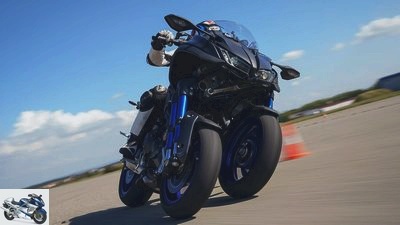
jkuenstle.de
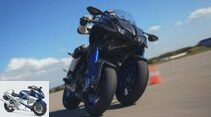
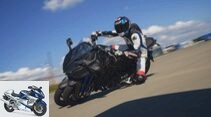
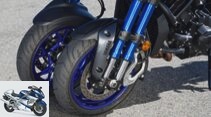
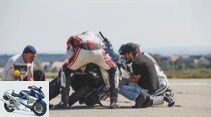
23 pictures

jkuenstle.de
1/23
The Yamaha Niken does not fit into any grid and for many does not fit into their motorcycle worldview.
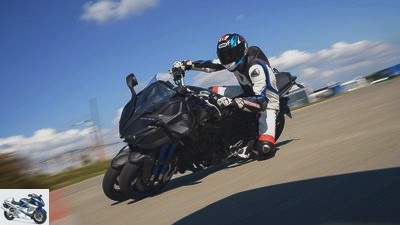
jkuenstle.de
2/23
Niken can be inclined with no ifs or buts.
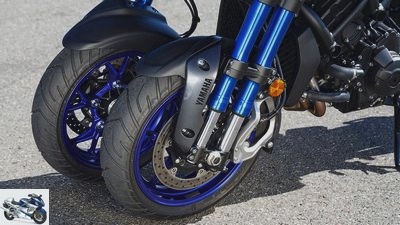
jkuenstle.de
3/23
Two 15-inchers, no speed axis: The two 41-inch stanchions have to be connected by a stable clamp.

jkuenstle.de
4/23
How weird is it? With united forces in search of freedom from lean angles. Theoretically, because the forks and shock absorber naturally compress a lot more when the vehicle is in motion.
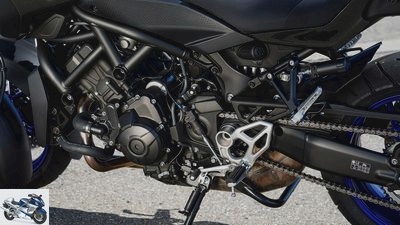
jkuenstle.de
5/23
It works like this: hard-shifting gearbox, somewhat stubborn quickshifter (standard).
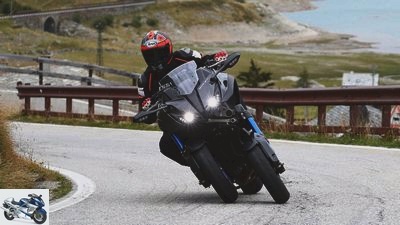
fact.de
6/23
At the Splugen Pass, Niken was able to show what she can do.
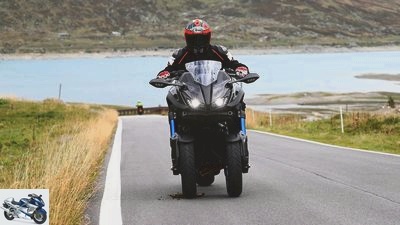
fact.de
7/23
On the country road, the consumption is 5.0 liters per 100 km.
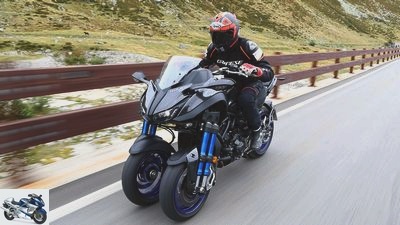
fact.de
8/23
The theoretical range with one tank of fuel is 360 km (country road).
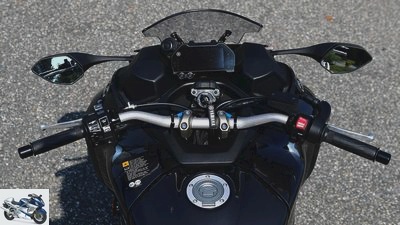
jkuenstle.de
9/23
Getting used to: view of the sweeping front section and the wide tubular handlebar (88 cm).
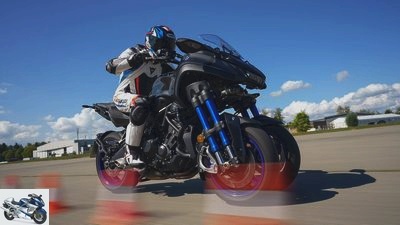
jkuenstle.de
10/23
The Niken needs 3.6 seconds up to 100 km / h, at 190 km / h it is over.
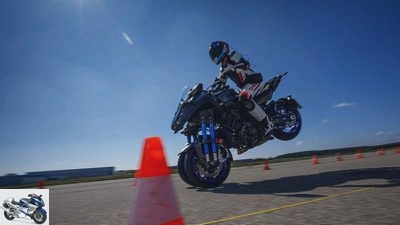
jkuenstle.de
11/23
And up the rear: When measuring the brake, the Niken hails the rising rear wheel. The Niken needs 43.4 meters of braking distance from 100 km / h.
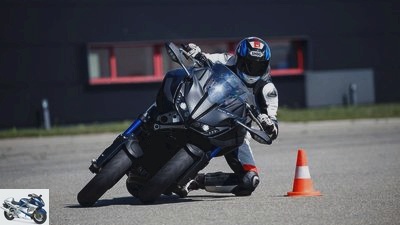
jkuenstle.de
12/23
Despite her full body, Niken wags surprisingly light-footed through the fast slalom course.
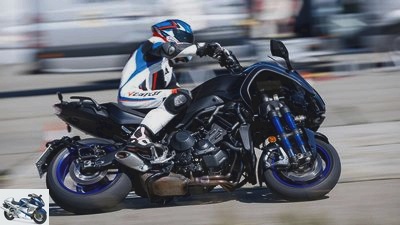
jkuenstle.de
13/23
Yamaha promises a possible incline of 45 degrees, and that seems rather deeply stacked.
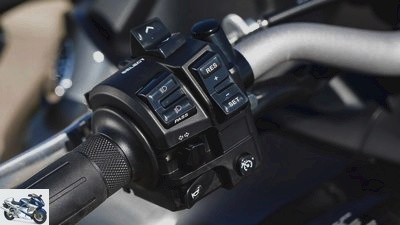
jkuenstle.de
14/23
Logical operation, good equipment: The control unit on the left end of the handlebar is tidy, the menu is controlled via the upper rocker, the standard cruise control via the lower one.
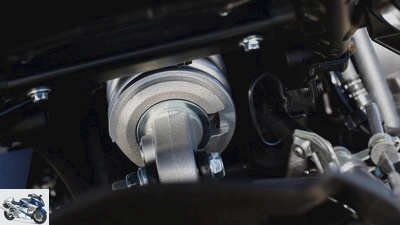
jkuenstle.de
15/23
Uncomfortable: The shock absorber is rough for solo operation compared to the comfortable adjustment of the front wheel position, there is no negative spring deflection. With two people it is then true.
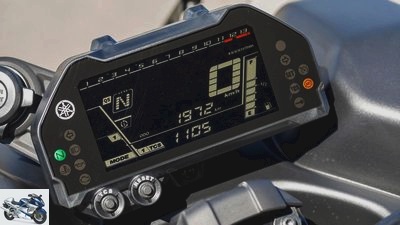
jkuenstle.de
16/23
No TFT display: a four-color display is now expected on a 15,000 euro motorcycle. Three motor mappings can be controlled via the right handlebar unit, traction control only from the cockpit.
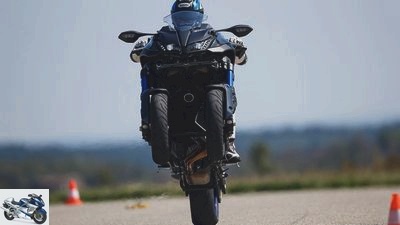
jkuenstle.de
17/23
With its 847 cm³ 3 cylinders, the Niken has 115 hp.
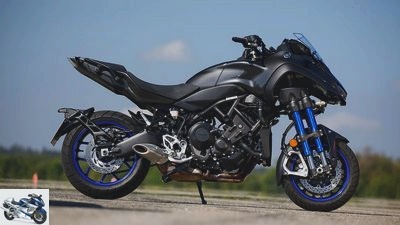
jkuenstle.de
18/23
The base price is 14,995 euros.
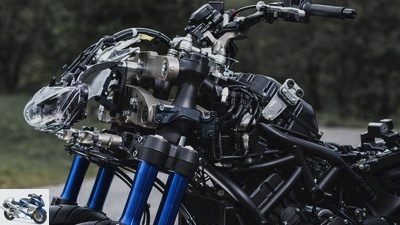
jkuenstle.de
19/23
The upper bridge only grips at the front, the lower one at the front and back around the fork mount.
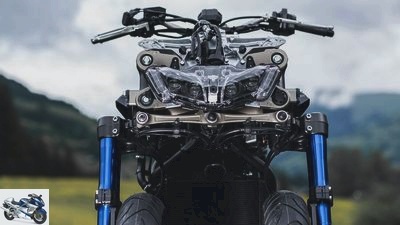
jkuenstle.de
20/23
Overall, there are many moving parts and bearings. It is amazing that such precise feedback and steering feel are possible.
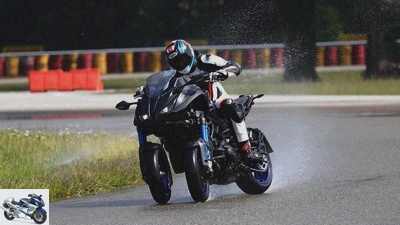
jkuenstle.de
21/23
When wet, the rear of the Niken oversteers.
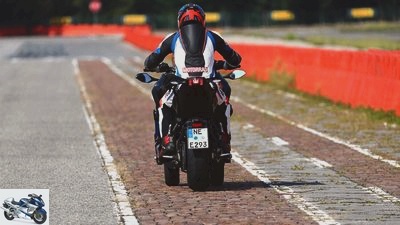
jkuenstle.de
22/23
On the rough road the rear prances out of the lane when braking.
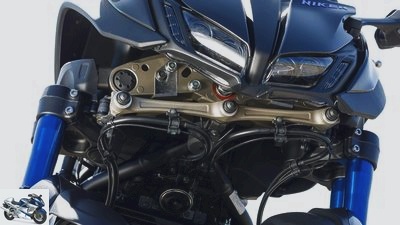
jkuenstle.de
23/23
The view below the headlights is extraordinary and takes getting used to.
motorcycles
Review Yamaha Niken
Yamaha Niken (2018) in the top test
Tricycle in everyday life & Test course
It doesn’t fit into any grid and, for many, doesn’t fit into their motorcycle worldview. The Yamaha Niken – in the top test that is a question of measured values and points, but in everyday life it is a question of perspective.
Stefan Kaschel
11/16/2018
Whichever way you look at it, it doesn’t get any better. From the front one wheel too many under the sweeping front section, from the driver’s perspective the wide cladding like a mighty bull’s neck between the legs and from the rear the proportional supergau made up of a slim rear section and a huge front end. No, a classic beauty becomes the new one Yamaha Niken never will. But that would have been a miracle in view of the technical requirements of this very special front wheel control, which so contradicts our viewing habits. So this miracle did not materialize. And it is actually more than pointless at this point to discuss whether the Niken is a beautiful motorcycle.
Buy complete article
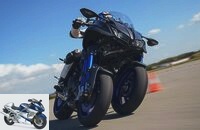
Yamaha Niken (2018) in the top test
Tricycle in everyday life & Test course
6 pages) as PDF
€ 2.00
Buy now
A motorcycle or not?
Rather, the most frequently asked question at the moment is whether the Yamaha Niken is a motorcycle at all. This long-legged twin tire arrangement under the insectoid headlights seems too alien, what is hidden behind it is too inscrutable for this construct to be immediately and unconditionally accepted into the large motorcycle family. It’s no use, only one thing helps: rigorously push the templates aside and give Niken a chance. The best way to do this is to try it out yourself. One thing is certain: After that, the Niken doesn’t look a bit more familiar, but the very personal motorcycle world has got one wheel richer. For those who drive themselves, one thing is clear: The Niken is unquestionably a motorcycle.
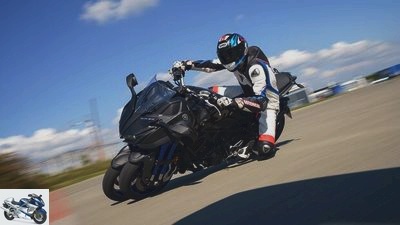
jkuenstle.de
Many do not consider the Yamaha Niken a full-fledged motorcycle.
At least that’s what happened to everyone in the MOTORRAD editorial team who tried their hand at the Yamaha Niken. And something else was amazing. Without exception, everyone spoke of “trust” when it came to describing the feeling the two small 15-inch front wheels with Bridgestone A 41 tires gave them, right from the first meter. Amazing because it is a complex, difficult to understand facial expression that somehow has to transport what the front wheels are doing to the handlebars. And something else is noteworthy: these signals are interpreted differently depending on driving skills. Experienced pilots who have developed an intimate relationship with their front wheel over the years also experience the alleged liability advantage, but much less intensely than those who usually travel with a respectful distance to the limits of driving physics. This also applies all the more the further the external conditions diverge from the ideal of motorcyclists. For example, on bad roads, in the rain or in the morning on the way to work.
The hour of Yamaha Niken
Who does not know that: the street is still wet from the cold, foggy autumn nights, plus tram rails, manhole covers and other hardships, the tires frozen through and rigid. This is the hour for Yamaha Niken, then she is in great shape. While on conventional motorcycles pointy fingers guide the handlebars and the brake lever is only stroked, on the Yamaha Niken one grips courageously and has full confidence in the double manager. If something slips here now, then it just slips – says the head. Broken, scratched plastic and bent fork tubes do not appear in this scene. The question, however, is in the room: Is the Niken really on the road with this safety plus with her two front wheels? Or, to put it another way: How far do we keep the distance from what is possible with just one front wheel in these situations??
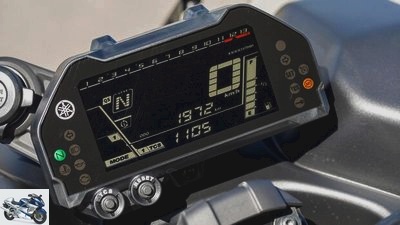
jkuenstle.de
The Yamaha Niken does not have a TFT display.
Change of location, Neuhausen ob Eck, a former military airport, MOTORRAD top test area. The Yamaha Niken in action, she wags surprisingly light-footed through the fast slalom course despite her full body. After his first contact with Niken, test driver Karsten was also somewhat astonished: “It really drives quite normally. I didn’t think that something like this could work so well. Respect for the Yamaha engineers who implemented this concept in this way. ”So there was no time to get used to it, like everyone else who drove the Niken. And that, although so much is in motion under the disguise. If the Yamaha tilts from one inclined position to the other, the fork legs move synchronously with one another as in a parallelogram. The wheel on the inside of the curve upwards, the outside wheel downwards by the same distance, and the more obliquely, the more. The ground contact of both wheels is guaranteed at all times, without first using the 110 millimeter suspension travel of the double fork beyond the dynamic forces of the vehicle. Yamaha promises a possible incline of 45 degrees, and that seems rather deeply stacked.
How does the tricycle fare on the test course??
It won’t fail here either because of the lean angle. “But of course it can be assumed that the Yamaha Niken won’t uproot any trees, even if it should have clear advantages thanks to the double tire contact area when braking and when leaning.” Expectations, and why, are obvious. The MOTORRAD top test course is a dynamic driving challenge at a high level. Fast slalom, slow slalom, circular path, braking from 100 km / h to a standstill – this is not about feelings or biker romance, but about fractions of a second. If you want to be at the forefront, everything has to be right. The grip of the front wheels is therefore only one aspect among many, it is at least as much about handling, braking, precision and stability. “The wide track of the Niken will also be a problem, especially in fast slalom”, suspects Karsten. “I have to Cycle further arcs than with a normal bike, because of the two wheels it cannot circle past the pylons as closely as usual. In addition, there is the impressive weight of 265 kilograms. That is almost 70 kilos more than with the MT-09, which is the basis for the Niken concept. Even the powerful Yamaha triple will have a lot to do with it, despite the shorter secondary gear ratio, when it comes to accelerating again after the turning points. “
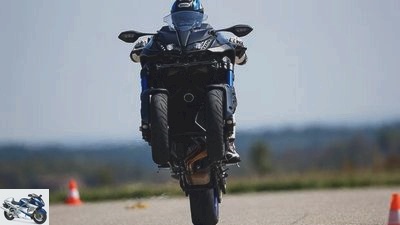
jkuenstle.de
Unusual picture: a wheelie with a tricycle.
Speaking of MT-09: Of course, MOTORRAD would have liked to have included the mid-range bestseller as a reference, especially since there is no direct competition in this case. However, Yamaha refused. However, because testing always and above all also means comparing, a different one was allowed to run. The KTM 790 Duke from the long-term test fleet, of course changed to the Niken series tires, is supposed to provide the reference values. After all, it comes very close to the MT-09 in terms of its systems and can show what a conventional motorcycle concept can do against the numerical wheel overhang of the Niken. Yamaha Niken versus the Duke: In view of the data and dimensions, it’s a bit like a travel steamer versus a speedboat, because the MT-09 has grown in every respect on its way to the third wheel and the new identity. Can the second front wheel compensate for these disadvantages? In short – no.
790 Duke shines with top values
The Yamaha Niken maintains a respectful distance from the Austrian in a hurry, but she also shines with top values and sets the bar very high with her combination of compact dimensions, low weight and lively twin row. However, that doesn’t mean the Niken is slow. On the contrary: especially in the circular path, it proves that this complex construction does not give in at great inclines, but is on par with such established sizes as the Ducati Multistrada 1200 S. In the fast slalom it stands up to a new BMW F 750 GS and holds a BMW R 1200 RT or the new 1100 scrambler from Ducati in check on the slow handling course. That is honorable, but not enough to prove the superiority of the new concept. But something else becomes clear: It is primarily not the functional disadvantages of the new front wheel suspension (which, by the way, would have been given an image-bearing name with the ending “-lever” at BMW), but rather secondary side effects that prevent better results. Above all, the weight distribution, which results from the complex steering mechanism and the duplication of many components.
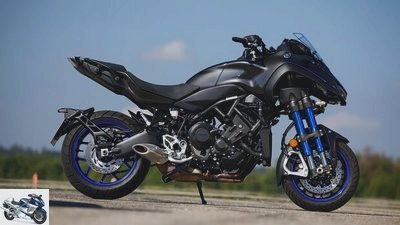
jkuenstle.de
Yamaha calls for 14,995 euros for the Niken.
A fat 152 kilograms weigh on the front wheels without a driver, only 113 kilograms in the rear. This corresponds to a weight distribution of around 57 to 43 percent and manifests itself in a pronounced top-heaviness, especially since the extra pounds are placed in front of the steering head and therefore very high and very far forward. “That means two things,” explains Karsten vividly. “During the slalom, the rear end is light at the turning points, while the front is stable. It is also this light rear that prevents better values in the braking measurements from 100 km / h. The hindquarters keep increasing, the ABS has to regulate. And besides, it doesn’t regulate precisely. ”That means: After 41.5 meters, the Duke is up, after 43.5 meters, the Niken. In other words: if there were an obstacle at 41.5 meters, it would hit at a good 20 km / h.
Advantages cannot be represented in terms of measurement technology
Disenchantment spreads, embarrassed faces. One thing is certain: here, on the top test course, the advantages that the two front wheels subjectively convey cannot be measured using measurements. But what to do, they are somehow available, but not under ideal conditions, on familiar terrain, with good grip and radii that have been practiced a thousand times, marked braking points. At the physical limit. The solution could be to go where it gets really edgy. The Pirelli test site at the gates of Milan is such a place. It not only has a tricky handling route, but also various linings with different coefficients of friction, and – very importantly – it can be flooded. The concept of the Yamaha Niken should also be able to show its advantages on the stopwatch.
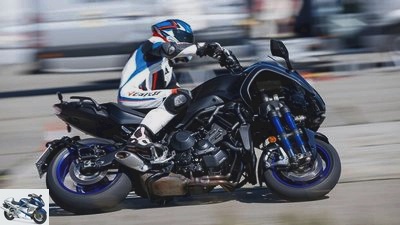
jkuenstle.de
The Niken’s engine comes from the MT-09.
The attentive reader suspects what has to come. The old wisdom that problems don’t get smaller when the difficulties get bigger also applies to the Niken cause. On a wet track, it’s not the exquisitely tuned, extroverted front that messes up the tour, but the conventional rear of the MT-09. It climbs on the brakes, when turning it wants to overtake the front left and right, which is stable on course, and when pulled, it does not find any grip even on the straight because the usual weight transfer to the rear wheel does not take place as usual due to the heavy front. What is the bottom line now? The realization that revolutions take a little longer. That every new technology has its pitfalls. And that it is still worth trying out new things. After all, anyone who has ever ridden a Yamaha Niken will never get it out of their head despite all reservations.
Wetness test – difficult conditions
When things get difficult, the Yamaha Niken should make it easier with its two front wheels. We tried it – on the wet track and in the Alps. You didn’t have to be an expert to know what was coming. The key data of the sweeping and above all heavy Niken spoke against new record values in the driving dynamics test, as long as the external conditions also allowed the conventional, but lighter concepts to perform a balancing act at the limit. So then: Pirelli test site at the gates of Milan, wet track with mini friction coefficients (0.4 and 0.7 µ) cobblestones, the whole horror cabinet. And on the way there is the Splugen Pass, bad asphalt, the tightest hairpin bends – this is where the Niken double whopper should show what it can really do. And it does, at least as far as the fore-hand is concerned. Shines with exquisite responsiveness, keeps the track stably, irons everything smoothly, and that without missing feedback or diving unduly when braking.

jkuenstle.de
How does the Niken do in the wetness test?
On the contrary, the anti-dive function is clearly noticeable, and the braking feel is good despite the rather blunt pads. But even here you simply cannot avoid the restrictions. At Splugen, with its tight bends, it is the sheer mass, the dimensions and the high center of gravity that nudge the Niken into the parade. Where the lively KTM offers different and above all narrow lines in the tight bends, there is often only one option on the thick Niken – almost like with a car. Confidence in the front wheels doesn’t help either, which shines here thanks to its comfortable set-up and fine responsiveness, but also because of its low sensitivity to grooves and frost breakouts. Unfortunately, there is also a less well-coordinated rear section, which, in contrast to the Niken front, delivers hearty blows at least in solo operation. This coordination with practically no negative spring deflection clearly reveals its weakness in the braking measurements in the wet. A tail that is becoming light and which quickly goes off track under the influence of ABS. Another problem is revealed in the acceleration phase at the exit of a curve. While the front stoically stays on the desired line, the rear tire simply doesn’t find any grip and oversteers sustainably. This continues down to the straights, the KTM is taking the Yamaha Niken down meter by meter. The suspected cause: Because of the top-heavy front section, too little axle load is transferred to the rear wheel. The traction control is always switched off during these measurements because it regulates too early.
Commentary by Stefan Kaschel
So here I am with my talent. First I praised the new Yamaha Niken and its second front wheel at the presentation about the green clover, now I have to explain why this is not reflected in the measurements. But I can. Because there are two different things, the MOTORRAD top test and the critical self-test. In the top test, a professional moves out on familiar terrain under ideal conditions in order to define the limit of the material. In the self-test, everyone first reflects on their own possibilities and then looks for the appropriate subset. In other words: Karsten moves motorcycles to the limit of the material. Others reliably come across their own first. And thanks to the second front wheel – I’ll stick with it – it will be easier for them to experience new limits. Just a matter of the head.
MOTORCYCLE conclusion
Will Valentino Rossi be out with two front wheels anytime soon? No, definitely not. But that’s not the point either. It’s about the fact that such an unusual vehicle concept enriches our motorcycle world, because that’s what the Yamaha Niken undoubtedly does. Hopefully Yamaha has staying power – the Niken deserves it.
Related articles
-
Aprilia tricycle patent: attack on Yamaha Niken?
News 2022 New motorcycle items for 2022 Aprilia 6th pictures Aprilia 1/6 Newly emerged patent drawings show an Aprilia with two front wheels. Aprilia 2/6…
-
Yamaha Niken support vehicle in the Tour de France
Yamaha Sports & scene Events Yamaha Niken support vehicle in the Tour de France Yamaha Niken at the Tour de France Support vehicle for the next 3 years…
-
Comparison test Kawasaki Versys 650, Suzuki V-Strom 650 and Yamaha Tracer 700
www.factstudio.de 27 pictures www.factstudio.de 1/27 Crossover comparison test with the Kawasaki Versys 650, Suzuki V-Strom 650 and Yamaha Tracer 700….
-
Concept comparison: Honda Fireblade, KTM 990 Super Duke R, Suzuki GSX-R 600, Yamaha FZ6
Gargolov motorcycles Concept comparison: Honda Fireblade, KTM 990 Super Duke R, Suzuki GSX-R 600, Yamaha FZ6 Concept comparison: Honda Fireblade, KTM 990…
-
Markus Jahn 33 pictures Yamaha 1/33 New sweeper in the middle class: Yamaha XJ6. Yamaha 2/33 New sweeper in the middle class: Yamaha XJ6. Yamaha 3/33 New…
-
fact 16 pictures Yamaha 1/16 Yamaha 2/16 Yamaha 3/16 Yamaha 4/16 Yamaha 5/16 Yamaha 6/16 Yamaha 7/16 Yamaha 8/16 Yamaha 9/16 Yamaha 10/16 Yamaha 11/16…
-
Bilski motorcycles Review Yamaha XJ6 Diversion Review Yamaha XJ6 Diversion XJ6 in touring suit Time to celebrate a motorcycle that wants to be nothing…
-
Second hand advice Yamaha Vmax
fact counselor Used purchase Second hand advice Yamaha Vmax Second hand advice Yamaha Vmax Max the last In 18 years of sales, the Vmax mutated into a…
-
Yamaha YZF-R1 driver assistance and chassis
bilski-fotografie.de counselor workshop Yamaha YZF-R1 driver assistance and chassis Assistance systems and chassis of the Yamaha YZF-R1 The perfect match…
-
motorcycles Review Suzuki SV 650 S Review Suzuki SV 650 S Blind date Positioning. The Suzuki SV 650 S meets the Honda CB 500 S, the Yamaha YZF 600 R, the…